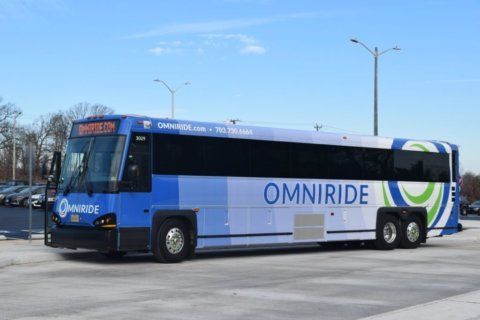This article was republished with permission from WTOP’s news partner InsideNoVa.com. Sign up for InsideNoVa.com’s free email subscription today.
This article was written by WTOP’s news partner InsideNoVa.com and republished with permission. Sign up for InsideNoVa.com’s free email subscription today.
The Prince William County School Board offered high praise for Superintendent LaTanya McDade’s proposed four-year strategic plan Wednesday night, lauding the increased achievement and staffing goals it lays out.
McDade’s plan features a series of targets around academic achievement, student social-emotional wellness, community engagement and internal division-wide organizational standards to be met over the next four years.
On academics, McDade hopes to significantly increase early childhood, pre-professional and dual-enrollment opportunities for students. The plan also has aggressive performance targets, like raising the on-time graduation rate from 92.8% in 2021 to 95% and increasing the percentage of students achieving passing scores on reading and math standards of learning exams to 85% in grades three through eight. It also includes specific goals for target populations like English-learners and students with disabilities, for whom the goal is to reduce dropout rates by 10% or more.
“Success comes when all schools and the division share a vision for success and are aligned to the same four commitments and are aligned … with everyone working towards the same north star,” McDade told the school board in a presentation Wednesday night. “We have set ambitious goals for Prince William County Public Schools. PWCS serves as the foundation for our county. We will continue to prepare students to be the citizens and leaders of tomorrow.”
McDade also spent time detailing the process for how progress on the plan’s goals would be monitored, saying that every division department would be tasked with completing an annual strategic plan and providing updates on what goals it is or is not on track to meet, and making adjustments accordingly. The plan features targets for school staffing, like adding 350 new international teachers (from 103 currently), helping 75 teaching assistants become certified special education teachers, and increasing the diversity of the county’s teacher pool.
The division plans to establish a program to help cover the educational and certification costs for teaching assistants to become special education teachers, an area where county schools are facing a particularly big shortage.
School board members praised the depth and ambition of the plan, saying it would mark an important shift in the right direction for the second-largest school division in the state.
“I don’t think it could be stated enough how much of a cultural shift this is, and I believe in the right direction,” Woodbridge Boardmember Loree Williams said, applauding the accountability and progress-watching McDade promised. “Understand that our division has shifted. Sometimes we get caught in ways of doing things that we’ve done in the past, and this is a fresh look and a fresh outlook on the direction Prince William County schools should be going in, or will be going in.”
Occoquan Boardmember Lillie Jessie even said that the plan was evidence that McDade was the right hire last year to replace Steve Walts as superintendent, who retired from the division after the 2020-21 school year.
“The board, I think we’re pleased with our selection. I think we did the right thing, ladies and gentleman,” Jessie said.
One of the biggest tools the division will use to make up the significant ground lost during school closures earlier in the pandemic is high-dosage tutoring, which has figured prominently into McDade’s plans for pandemic recovery.
The tutoring is supposed to feature small groups – ideally between one and four students – meeting during the school day providing students who fell behind over the last two years extra instructional time. McDade has said that different schools have had varying levels of success in hiring tutors, but that research has shown the method to be particularly helpful in getting struggling students prepared for what’s coming next by focusing on certain core standards.
“We all know that students have lost opportunities to learn over the last two-and-a-half years due to the pandemic, and all of those gaps can’t possibly be filled this year or next year,” said Associate Superintendent Rita Goss. “We don’t have time to fill in every gap that students have in their learning, we have to be strategic and targeted, we have to look at the most essential standards.”
Prior to McDade’s presentation and the board’s discussion of the plan, the public also weighed in during a public hearing.
Rose Quint, the parent of both a recent graduate and current high school sophomore, praised the plan’s emphasis on raising the achievement levels of Black and Hispanic students, who’ve trailed White and Asian students by increasing margins on state standardized tests since the pandemic began.
In 2021, 31% of all division students earned advanced exam credit, but for Black and Hispanic students, the percent was just 22 and 20, respectively. McDade’s plan includes a goal of increasing the participation of economically disadvantaged, minority students, English learners and students with disabilities in advanced programs by 10%, but Quint urged the division to follow through on the goal of including more students in its most challenging curriculum.
“The … reason for my being here tonight is to urge you, to urge you to put teeth behind this goal. I say that because of my experience with my daughters, the system did not really exhibit an expectation of excellence towards them. It didn’t push them to push themselves, that expectation and that push came from their two educated parents” Quint told the school board and McDade. “Hire role models for these kids, … reach out to those parents, … train counselors to spot Hispanic kids who have very good grades but are not in a single advanced class.”
Others argued that the plan placed too much focus on racial equity and inclusivity, and that the division should place more emphasis on creating tolerance of differing political opinions. Palmer Denny, a Colgan High School student, said he’d been harassed in school for wearing a hat supporting Donald Trump.
And some said that the plan should focus less on juicing academic achievement to compensate for learning loss last year and place more of an emphasis on social and emotional wellbeing among students during a challenging period.
School board chair Babur Lateef tried to soberly remind the public of the challenges the division will face in realizing the goals laid out in the plan, primarily, he said, with regards to funding. According to McDade’s presentation the county ranks second-to-last in per-pupil spending among school systems in the greater Washington region at $12,641 per student (just behind Manassas and ahead of only Manassas Park).
And if the public and the Prince William Board of County Supervisors were excited about the potential new programming and advances in student achievement being hawked by the superintendent, Lateef said, they should be prepared to pay for it. McDade’s office has already begun work on the fiscal year 2023 budget.
“Plans cost money. … We need to do more on increasing the per-pupil spending,” Lateef said. “It’s unfortunate that in the real world we have to make cuts. … Recognize that this plan will cost money, it’s something that we are ambitious about. … That comes with an effort that we must increase funding to our school division. We have to make real gains on this [regional] chart, we cannot continue to be here at the bottom. If we do, we won’t achieve what’s in this plan.”







